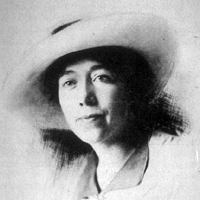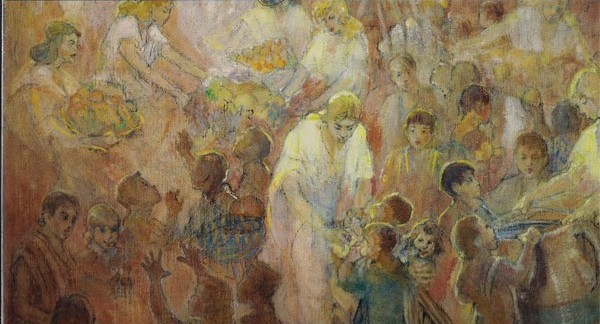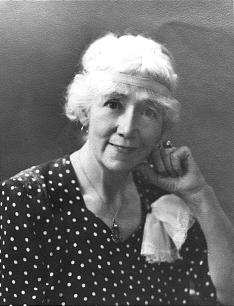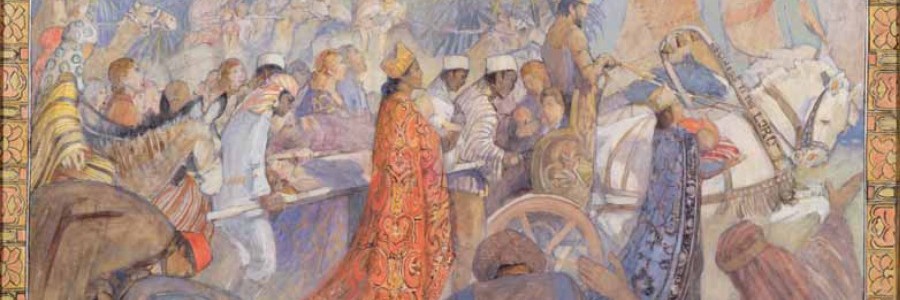Of all the superhero catch phrases, Wonder Woman’s frequent invocation of “Merciful Minerva!” puzzled me most as a kid since Minerva (the Roman version of Athena) represented wisdom and learning, inventiveness and the arts, hardly someone whose name and memory might embolden you to, say, lasso a giant alien with your golden lariat to save the earth. But as an invocation of Minerva Teichert, that fabulous Latter-day Patron Saint of Mormon art and artists, it’s most apt.
 Although Teichert (LDS) grew up on a ranch in Idaho as one of nine children, she somehow managed to find a way to study art in Chicago and New York under noted masters John Vanderpoel and Robert Henri during the 1940s and 1950s. And, even though shortly thereafter she returned to the western U.S. to get married and raise five children on a ranch in Wyoming, Minerva overcame the stifling burdens of the family business and household to continue pursuing her love of painting in her spare time.
Although Teichert (LDS) grew up on a ranch in Idaho as one of nine children, she somehow managed to find a way to study art in Chicago and New York under noted masters John Vanderpoel and Robert Henri during the 1940s and 1950s. And, even though shortly thereafter she returned to the western U.S. to get married and raise five children on a ranch in Wyoming, Minerva overcame the stifling burdens of the family business and household to continue pursuing her love of painting in her spare time.
While she painted numerous commissioned works of art, including murals in the Manti LDS Temple, her dream was to tell the Book of Mormon story in vibrant color, something she did in over forty murals painted on canvas tacked to the wall of her small living room. Working in such cramped quarters, she used inverted binoculars to view the murals from a distance for a proper perspective. The only client she served for this project was the Spirit, unless you count her eventual arrangement with Brigham Young University to pay for tuition for her children (among other students) with these paintings. As a result, BYU now owns most of these works, a few others being held by the church and in private collections.
Reproduced beautifully in the BYU-published text, The Book of Mormon Paintings of Minerva Teichert, edited by Welch and Dant, Teichert’s visual midrash on the Book of Mormon transforms this religio-historical text preoccupied with armed conflict into the kinder, gentler story found between the lines of the Book of Mormon, and this from a woman’s point of view, in peaceful, yet vivid colors, as if Edgar Degas had painted a ballet based on the Book of Mormon story. Allow me to take a look at two of these paintings with you.
 This painting, “Love Story,” is a wonderful transformation of the terse account of the marriage of Ishmael’s daughters to Lehi’s sons into a boisterous dance number right out of an Ancient Near Eastern “West Side Story” or “Seven Brides for Seven Brothers,” replete with tambourines and cymbals, billowing costumes, and flirtatious smiles. As in many of Teichert’s other paintings, the women steal the scene, as does the color red.
This painting, “Love Story,” is a wonderful transformation of the terse account of the marriage of Ishmael’s daughters to Lehi’s sons into a boisterous dance number right out of an Ancient Near Eastern “West Side Story” or “Seven Brides for Seven Brothers,” replete with tambourines and cymbals, billowing costumes, and flirtatious smiles. As in many of Teichert’s other paintings, the women steal the scene, as does the color red.
 In this more famous work, “Look to Your Children,” one finds the climax of the Book of Mormon story depicting angelic ministrations to children during the Savior’s visit at the Nephite temple. Teichert chose red, her favorite color, and one she associated with heaven, in a more muted tone, as the predominant color for this painting. While contemporary readers likely interpret 3 Nephi’s narrative of angelic ministration to these children as the more ritualistic act of giving priesthood blessings to them, Teichert transforms this scene into a literal feast, with angels serving children the way Welch and Dant suggest Teichert performed her own “grandmotherly acts” of serving food and caring for grandchildren (The Book of Mormon Paintings of Minerva Teichert , 146). The eye is drawn to the central angelic figure who ministers to a young girl by washing her face.
In this more famous work, “Look to Your Children,” one finds the climax of the Book of Mormon story depicting angelic ministrations to children during the Savior’s visit at the Nephite temple. Teichert chose red, her favorite color, and one she associated with heaven, in a more muted tone, as the predominant color for this painting. While contemporary readers likely interpret 3 Nephi’s narrative of angelic ministration to these children as the more ritualistic act of giving priesthood blessings to them, Teichert transforms this scene into a literal feast, with angels serving children the way Welch and Dant suggest Teichert performed her own “grandmotherly acts” of serving food and caring for grandchildren (The Book of Mormon Paintings of Minerva Teichert , 146). The eye is drawn to the central angelic figure who ministers to a young girl by washing her face.
 Inevitably one must compare Arnold Friberg’s illustrations of Book of Mormon events, which have appeared in the Book of Mormon for a couple of generations, with Teichert’s work. My suggestion is that Teichert and Friberg have created different Book of Mormon “gospels”: Friberg, as if Matthew or Mark, focused on the mighty acts and miracles of the heroic Nephites; whereas Teichert, as if Luke or John, focused on women, children, and themes of the heart. Few would doubt that we have been influenced in our reading of the Book of Mormon text in the last fifty or so years by the sheer ubiquity of the Friberg illustrations. If the only available Book of Mormon text for the next fifty years featured Teichert illustrations, wouldn’t her paintings change the way we view the Book of Mormon text as well? Wouldn’t we be drawn more toward the subtleties of the text, perhaps to its literary strengths, the stories of its handful of women and children, rather than to the familiar war stories, Captain Moroni, the two thousand stripling warriors, or a “soloflexed” Nephi?
Inevitably one must compare Arnold Friberg’s illustrations of Book of Mormon events, which have appeared in the Book of Mormon for a couple of generations, with Teichert’s work. My suggestion is that Teichert and Friberg have created different Book of Mormon “gospels”: Friberg, as if Matthew or Mark, focused on the mighty acts and miracles of the heroic Nephites; whereas Teichert, as if Luke or John, focused on women, children, and themes of the heart. Few would doubt that we have been influenced in our reading of the Book of Mormon text in the last fifty or so years by the sheer ubiquity of the Friberg illustrations. If the only available Book of Mormon text for the next fifty years featured Teichert illustrations, wouldn’t her paintings change the way we view the Book of Mormon text as well? Wouldn’t we be drawn more toward the subtleties of the text, perhaps to its literary strengths, the stories of its handful of women and children, rather than to the familiar war stories, Captain Moroni, the two thousand stripling warriors, or a “soloflexed” Nephi?
Join with me in taking Minerva Teichert’s name, not in vain, but in . . . productivity and inspiration … as one of our favorite Mormons. Merciful Minerva, indeed!
[Some portions of this post were drawn from my book review that appeared in a volume of the FARMS Review, reproduced at: http://maxwellinstitute.byu.edu/publications/review/?reviewed_books&vol=10&num=2&id=289]

Thanks, Ed.
I was wondering when you were going to get to her, because I knew you would, eventually!
My favorite of hers is _The Rescue of the Lost Lamb_. It hangs in the temple I attend, and I confess that sometimes I go to the temple mostly so I could sit and look at this painting.
http://www.lds.org/relief-society/daughters-in-my-kingdom/manual/a-wide-and-extensive-sphere-of-action?lang=eng
(scroll down)
I am also very pleased that you mentioned how she paid for tuition at BYU for her children. That is such a telling detail about her character, and I really love her for that. Such a cool person.
Hey Mark! Thanks for the link. She was one-of-a-kind. I dig her headband in the more mature pix of her too.
I want a copy of the Book of Mormon you suggest! You can tell from her paintings what a soft woman she must have been. I really enjoyed your acknowledging here: “Minerva overcame the stifling burdens of the family business and household to continue pursuing her love of painting in her spare time.” I admire (and feel jealous of) this in women around me all the time, both in history and in the present. She so obviously had a passion for painting and the Christ story of the Book of Mormon.
Ed, I love this so much, especially the last paragraph.
I have such a soft spot for the Teichert paintings. It really would be wonderful to imagine the next 50 years of the Book of Mormon colored from her point of view.
I have long loved Minerva’s paintings. Her style really strikes a chord with me.
Love this. Thanks for sharing. I really didn’t know much about Minerva. I’m also interested in a Minerva-illustrated BoM.
Warning! plug for Deseret Book! Deseret Book is selling an Heirloom Edition of the Book of Mormon with Tiechert’s paintings in it. It is on sale for about $50. I’ve seen it in there a few times, but after reading this I’m inspired to buy it.
http://deseretbook.com/Book-Mormon-Heirloom-Edition-Deseret-Company/i/4236873
Moss, thanks for the tip–just ordered one!
I am going to order one too!
I love this, Ed: “…as if Edgar Degas had painted a ballet based on the Book of Mormon story.”
I also love the paintings of Teichert. I have an enormous framed print of “Christ in a red robe” in my home, and I love the gentleness of her depiction of him. Your insight about how her artwork could subtly influence our readings of the BOM and perhaps nudge them from the territory of the pec-obsessed AF images really resonates. Yes!
Frieberg’s muscled men cannot compete with Teichert’s dancing pastels.
she’s my great grandmother. I love her.
Hi Nicole–I’ve adopted myself as her grandson! Figuratively speaking–it’s like my own matriarchal blessing I made up for myself.